|
Somewhere it is written that the average sailboat is under power about 50% of the time it is moving. Recognizing that Dolphin owners are not your average breed most of us use our motors a lot more that we care to admit.
Many Dolphins have outboard engines either mounted in their transom well/lockers or hung on the transom. In the early days 1960-1965 transom wells were usually an option selected when the boat was made vs an inboard which was the standard version, or sometimes a later retrofit by an owner changing from an inboard. Most Dolphins built after 1965 had OB motors in a transom well. Transom wells and their plugs are a whole subject to themselves - click here to read about them.
Any decision made will depend on how owners value the many different, interrelated and often conflicting factors. As usual with boats, compromises are necessary, and rationalizing/defending your decision is a requirement. The following is a starter list of many the factors involved:
- Sailing area - strong currents/dependable breeze
- Boat use - primarily racing, cruising, both?
- Boat home location - in a slip with power, mooring, trailer sailed?
- transom OB bracket - appearance/performance issues/handling
- motor performance - horsepower/boat speed - thrust to prop/prop size
- motor performance - aspiration issues in a transom well
- water entry into the transom well from following seas
- weight/size/ease of handling
- weight/location/size of support systems - batteries,cables, fuel tanks, controls, etc.
- storage location of motor when not in use
- extra long/long shaft/short shaft issues - performance, storage
- loss of sailing speed with motor in place and not running
- location of weight issues as they affect boat speed and performance
- noise
- fuel efficiency
- pollution variables - 4 stroke/2 stroke/motor performance
- electric start yes or no
- alternator yes or no
- reverse yes or no (weight issue)
- motor servicing at home/or shop
- motor reputation/reliability
- price (almost forgot this one!)
- Electric outboards? a whole other story that needs development (click here for a link)
- keeping the barnacles off, out of your motor
Each Dolphin owner confronting this problem, and the above headache inducing list, secretly wishes that their boat had a light weight diesel, with maybe a feathering prop that works well in reverse, and most importantly one that someone else paid the $7-8K cost. With this caveat out of the way the first step is to prioritize the above list for the needs of the specific owner. This article will attempt to flesh out each on the above factors with imput from various sources including owners themselves.
The following comments expand on the above and offers your webmasters' somewhat biased comments
1) $$$ - new motors can be pretty expensive
2) if you plan to leave the motor in the well when sailing, or at a mooring, weight/handling is not a big issue - except for boat sailing performance. The lighter the better in the boat ends, and then there is prop drag... and barnacles/seawweed growing....
3) A larger, fixed in place motor, means rowing the dinghy/inflatable, or yet another motor
4) If you going to have a fixed in place motor you may as well get a motor that has enough power, 6hp min, I think. If you can get a 8hp at the same weight, probably better
5) older design 2 stroke motors are dinosaurs - less efficient, noisy, more polluting vs 4 stroke and some new 2 stroke designs. Some places, like some lakes, you cannot even have them. Maybe in the not too distant future these will not be allowed in some coastal waters/harbors??
6) Reverse gear is nice, but heavy, and expensive. Turning around the motor in the well can be done, and I do it - but rarely. If I do have to do its because I did not 'plan' my approach properly. Smaller motors are easier, and possibly even necessary, depending on motor well clearance issues. Maybe not as much as a problem on Yankee's and Pacific Dolphins - they have a larger well and more clearance than O'Day Dolphins, I think.
7) Alternators take a surprising amount of power - a larger, more powerful motor, ie., an 8hp vs a 6hp, all other considerations being equal, might be a better choice
8) extra long vs long shaft vs short shaft – longer is more efficient as prop is deeper and more out of the turbulent water - but heavier and more expensive
9) The type prop on your motor can make a substantial difference. Ask the dealer about low pitch, high thrust props that will maximize performance for a heavy displacement sailboat. Even if you are not getting a new motor check out if your prop is right.
10) my 4hp pushes Marionette, calm sea, no head wind at 4.7 knots - a full knot!!, or about 20%, below hull speed. There is that 50% rule - the time a sailboat is under power vs under sail - a big factor. According to this rule a 250 mile cruise to Maine will be 50% under power, and during that time - with an underpowered motor - be travelling 20% slower than it could, adding many hours, up to a whole day longer trip. To really appreciate this underpowered issue add a 10 - 12 knot headwind and a 2 - 3 ft chop to the mix. For more information on Marionette's old, 32 lb, 4hp Johnson, and its issues, click here. Still, I am happy with my choice
11) make sure you check out all the clearances, particularly for a no reverse gear motor in a well. Also, the clearance between the prop and the rear of the rudder when the motor is turned around can be a problem. You can tilt the motor a bit away from the back edge of the rudder - I do this anyway as the boat tends to squat when under power going forward and a slight tilt brings the motor shaft back to perpendicular under power. This tilt then has the added effect of giving the prop more clearance when the motor is turned around.
Your webmaster has had several email exchanges on this subject with Dolphin owners and it seemed that a collection of commentary would be of interest to all. Different points of view and new information to update this are encouraged. The goal is to provide more grist for our intellectual exercise on powering decisions.
**************************
We'll start with a thread lifted from previous comments made by Dolphin owners on the Sailnet Dolphin 24 Forum in 2006.
I shoe-horned a Yamaha 9.9 four stroke long shaft, high thrust, electric start (I am now spoiled) into Charisma. I do not rotate the motor to navigate, I use only the rudder. I find it very easy to negotiate in and out of my slip. You just need to understand that the Dolphin is not a power boat or a dinghy - they maneuver like a larger, say 34’ boat.
I run the motor with the well cover open and push the outboard control arm into the down position to close the cover while sailing. Having the control arm sticking out into the cockpit doesn’t seem like a good idea to me, seems like it would be in the way as well as something for the main sheet to hang up on.
The 9.9 generates way more power that the Dolphin needs, 1/3 throttle keeps us at 4.5 knots with enough extra power to buck the current at our bar during an ebb tide. Last year I filled the 3 gallon tank and at the end of the season had a gallon left over. I know some of the earlier Dolphins had inboard engines; I would love to see some photos if anyone has them.
Ken Thompson, Charisma, Yankee # 208, Brookings, Oregon
Webmaster Note: Click here for a link to the Yamaha 9.9 hp website/specs
*************************
I have a Pacific Dolphin, hull # 280. Like Ken, I have a large outboard in the motor well, Johnson 9.9 two stroke with a long shaft. I find it very easy to enter/exit the slip without turning the motor. I run the motor with the cover open and push the outboard control arm down to close the cover. Noisy, but this works well. Yes, 9.9 is a lot of power for the Dolphin, but I do not 'power boat'. Understanding how the boat maneuvers will allow for easy handling at slow speeds. Working on trying to sail back into the slip with out the motor, not quite there yet.
Harold Shomaker, Sailing Solace, Pacific Dolphin # 280, Palm Harbor, Florida
*************************
|
I purchased a Nissan 6 hp long shaft for my Dolphin (no alternator, though), and have been very pleased with the results. While I initially fitted an 8 hp Nissan (smallest two cylinder Nissan makes, which I would have preferred), the 8 hp wouldn't turn in the transom very well
I find that steering in the marina by rudder alone too difficult at low speeds. In contrast, with the 6 Hp, the motor rotates easily. The only catch with both motors is that the fuel connector, which is at the front of the motor (i.e. towards bow), gives very little room for the fuel line and it will occasionally kink. I haven't been able to find a right-angle compatible Nissan fuel line connector (feedback welcome).
BTW, I also have a backup 2 Hp Honda. While noisy (air cooled), it moves my Dolphin along fairly nicely so long as I'm not fighting current. I was surprised, but I can get four knots at full? throttle. Not recommended for regular use, but as a backup, works nicely and is light weight (35, maybe 40 lb?).
Craig Burkhead, Aviva, 1967 Yankee, Alameda, CA
Webmaster Note: Click here for a link to the Nissan 6 hp website/specs |
*************
Thanks to all for the recommendations. I purchased the new 6 hp Tohatsu 4 stroke with extra long shaft and a 7 inch pitch prop instead of the stock 8 inch. It runs great, sips gas, and moves the boat well.
Todd Phillips, Cove Dweller, Yankee # 111, St Michaels, MD
Webmaster note: Click here for a link to the Tohatsu 6 hp website/specs
***************
A quick question on the Tohatsu 4 stroke 6 with extra long shaft - when the motor arm is straight up, can the motor well top still close (a problem with the Suzuki). Does the arm pull back further than 90 degrees from horizontal?
Looking for an outboard but want the motor well to close and lock, obviously, when not in use. Thanks.
Kevin O‘Leary, Delphinidae, Pacific Dolphin # 256, San Diego, CA
*********************
The motor arm pulls back further than 90 degrees and I can easily close the lid. Additionally, you can run the motor with the lid closed because the exhaust is through the prop hub***. It comes with an alternator to charge the battery. I ordered online from www.defender.com and had it within a week. There are other online suppliers with good prices as well.
Todd, Cove Dweller, Yankee # 111, St Michaels, MD
******************
*** Webmaster Note: Exhausting through the prop. It would be interesting to hear from more Dolphin owners that have these kinds of motors. Proper aspiration of the motor in the well is a big factor. My Johnson 4hp on Marionette exhausts its cooling water and exhaust fumes together directly from an outlet immediately below the rear part of the head. The hole in the hull for the shaft is often/usually blocked with water as the aft part of the hull squats when moving forward - so the fumes cannot get out below. If I close the hatch cover, within a few seconds the well is filled with fumes, depriving the motor of sufficient oxygen.
Another problem is the exhaust stains the inside edge of the shaft hole, on its way down to fouling the water! Besides the prospect of $10 gas this is one more reason to think about electric motors...
************************
January 2, 2009 Todd has since sold Cove Dweller but he recently offered the following in response to Erik Even’s (Robin Lee, Yankee # 118) request for info on his 6hp Tohatsu extra long shaft motor (emails consolidated and edited)
|
I sold my boat but would be happy to recommend the Tohatsu 6hp, I was glad that I had the extra long shaft when the boat would get into some heavy chop as I think the shorter shaft might have popped out of the water in the troughs. I also ordered a smaller pitch prop than the standard for more power. I purchased the motor through Defender.com.
The 6 hp extra-long shaft was more difficult to get in and out of the well than I originally envisioned. I had planned on taking it out at the end of every weekend and did that for about two months. I ended up putting antifouling paint on it and leaving it in place. I doubt that the extra long shaft motor would fit in the well but can't remember that I ever tried - perhaps the long shaft would be better.
The only issue with the motor is where the fuel line female connector fits into the male connector mounted on the motor. On my boat it caused the fuel line make a tight 90 degree bend because how close the female connector ends up near the forward bulkhead of the motor well. Also, the normal vibration of the motor and hose cause chafing of the fuel line at that point. I ended up disconnecting the male connector where it attached to the motor (a single bolt), and then mounting the male connector at a 90 degree angle to an existing hole in the lift handle of the unit (using same bolt and adding a nut).
I did get the alternator but ended up never even trying it out.
Todd
|
Here is the link to Tohatsu's 6 hp outboard http://www.tohatsu.com/outboards/6_4st.html
*************
November 15, 2009 Terry Bullock (Yankee # 109) sent in the following comments about his new 5 hp Honda - minor edits.
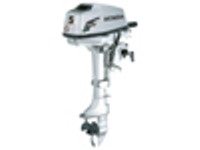 A lot of things to consider when buying that new one. A lot of things to consider when buying that new one.
Mine is a Honda 5hp, 4 stroke, short shaft, alternator can be installed but not standerd equipment on this horsepower. I chose it because after looking at what is available on the market, its design , material used, and the warranty was better than the other manufacturers.
Before buying it I went to the dealer and measured to see if it would fit and every thing looked good. Purchased the motor and the next trip to the boat dropped it in, started it up and every thing was fine until when shifting into reverse the back of the motor was rubbing on the teak backing plate for the back stay. I removed about 3 inches from the bottom of the backing all the way to the fiberglass and it fit with no rubbing.
I have never found a motor with enough horse power that could be turned in the well. Straight forward only. My choice of a short shaft was ease of installation and weight because the motor has to be removed and stored when not in use. The only other thing different from the last motor - a 4hp, 2stroke - was the idle speed is a little higher so coming into the dock takes getting used to.
Terry, Dolphin #109
Webmaster note: Click here for a link to the Honda 5 hp website/specs; and click here for a link to the Honda 8 hp with reverse and alternator
************
January 17, 2010. Jim Robinson has a Yamaha 9.9hp long shaft in his Aquila, Pacific Dolphin 24, #273. His email is below. For those of you who wonder about the weight of this motor, 109lbs, Aquila also has a new rudder that weights 45lbs! less than the old rudder. Click here to check it out.
|
Hi Ron,
I have a Yamaha 9.9 long shaft (27 inch) high thrust 4 stroke. It's an electric start with a cable control unit to the cockpit. It replaced a Mercury 9.9 long shaft 2 stroke (1980 model) without controls.
I sail out of Morro Bay, Ca., which is subject to impressive currents (5 knots, or more, at times) through the entrance and the extra horsepower verges on a necessity. The biggest issue I encountered in switching motors had to do with the inboard motor well. I had considered a Honda 9.9 but it was too large. I had to do some grinding to fit the Yamaha into the well. The four stroke engine tended to run hot within the well (hatch down) so I added fans at both in and out ventilation cowls. The fans are actually louder than the Yamaha with the hatch down. I have been asked more then once if I'm running an "electric" motor.
The motor is very smooth, fuel efficient, and the longer shaft works well in Pacific swells. It does weigh 109 pounds (old motor was about 70 pounds) and I was concerned about how it effected the boats balance. I didn't notice any appreciable change. I use the boom and mainsheet to hoist the motor in and out of the well for annual maintenance.
I'll take some pictures of the motor in the well and send them along. (see below)
Jim, Aquila, #273
|
*******************
January 26, 2010. Operating an outboard in a well brings up aspiration issues - getting enough clean air to the motor. Motoring around the harbor with the hatch open is hard on the psyche when people are pointing their cameras at you. Your webmaster has been solicting comments from owners about this matter. Jim Robinson's solution for Aquila is below.
Ron,
I lost a heat sink on a used 4 stroke 9.9 from that same problem, overheating with the hatch down -- but with this new 9.9 (Yamaha) I have an alternator so I can run those little fans hooked up to the air intake cowl and exhaust cowl.
I was looking at a picture of your transom locker and it appears that once the hatch is down there air flows primarily from the well. It might be helpful to have an air "flow" in or out above the waterline. Have you considered a pair of low profile on deck cowls above the locker facing fore and aft to help the air flow. I have them, and I believe that was a factory installation on the Pacific Dolphin, The previous owner ran a two stroke 9.9 without any reported heating utilizing only the air cowls. I figured the four stroke creates a bit more heat and /or exhaust and may gulp the air. That's my working theory. Since your transom is self bailing any water coming flooding through the cowls in seas would be negated.
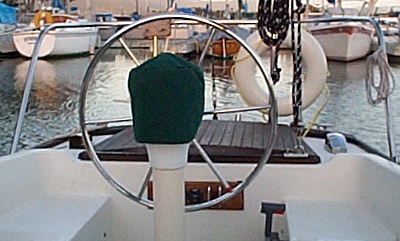
This is an older picture -- poor quality -- but you can see the port cowl on deck facing aft and then starboard cowl facing forward. I created some weather covers for the cowls cut out of plastic jugs. People want to know where I bought them!
I'll send some better pictures when it clears ---it's raining, again, tomorrow.
Jim
Jim updated his comments on February 10 about his Yamaha 9.9hp and its aspiration. They appear below.
Ron,
Here's a picture of the cooling system I mentioned on my Dolphin.
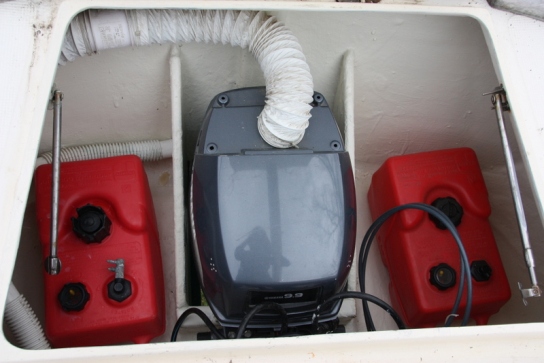
This is how I keep my Yamaha four stroke 9.9 cool with the hatch down on the transom.
The ducting pictured is attached to a deck cowl on the left. That "plastic band" in the duct in the upper left of the photo is a 12 volt blower/fan bringing air in. I have a " low loop" in the duct (unseen on left, under the deck) to trap water or moisture and drain through a small hole. I removed the intake cover on the motor and secured the duct to the existing port into the engine.
Not pictured, but on the right is another blower/fan connected to another deck cowl which draws air out of the transom. I concocted this system after repeated issues with an "oxygen starved" outboard. The Yamaha has an alternator so the fans are essentially powered by the motor. Synergy!
It was probably over kill but I drilled a half dozen small holes into the forward part of the engine cover to facilitate the air exchange. I've had the motor in the boat over 3 years (2 of those in the water) and I have no corrosion issues under the engine cover.
You can see that the motor was a tight fit into the transom. Those are shift and throttle control cables in lower right which lead to cockpit.
Jim
*******************
February 1, 2010 Erik Evens, Robin Lee, Yankee #118 made a post on the Forum today regarding his transom well, plug and new Tohatsu motor. To see the full post click here. Below are his comments (edited) relating to the new Tohatsu 6 hp.
|
I've had a chance to get my new Tohatsu 6 hp extra-long shaft engine up and running. Still breaking it in, but so far, so good - the motor seems to be a very good one indeed. Came all the way from Tennessee to California, and I took it out of the box, put oil in it, filled the gas tank and hooked up the hose, and pulled the starting cord ONCE. Started right up.
I've installed a pulpit-mounted outboard bracket (West Marine), which allows me to lift the motor out of the well, and store it securely mounted to the stern pulpit. This means the moving the rather heavy motor (60 lbs.) around is reduced to a minimum.
Todd Phillips advised me that the fuel hose attachment faced forward on the front of the motor, and pressed against the forward bulkhead of the lazarette, and he was right. Using his recommendations as a starting point, I modified the installation with a new, longer fuel line, and re-routed the fitting to face starboard. A couple of cable ties attach the new piece of fuel line to the lifting handle on the front of the engine, making for a clean installation. See below:
|
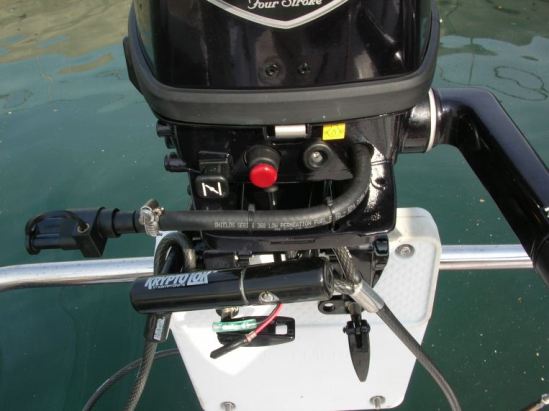
February 2, 2010 On a follow up email Erik adds
I’ve heard nothing but good things about Tohatsu. Apparently they are the largest manufacturer of outboards in the world, and make many of the small motors in the Mercury line, and all of the Nissan motors are relabeled Tohatsus, at slightly higher prices.
My motor is manual start, but has reverse gear. I tried the reverse out, and it’s an interesting experience in a Dolphin, because the prop washes directly over the rudder in reverse. So it wants to gain purchase on the rudder and pull the tiller right out of your hands. At slow speeds it’s really ok, but it takes some getting used to. My motor has an alternator, which I will be hooking up when I get the chance to do the wiring.
**********************
April 5, 2010. We asked Erik to tell us if hisTohatsu will rotate in the well, and if yes, how much. Some owners feel more comfortable in close quarter mauevering if, in a pinch, they could rotate the motor. Here is a picture he sent in and his comments:
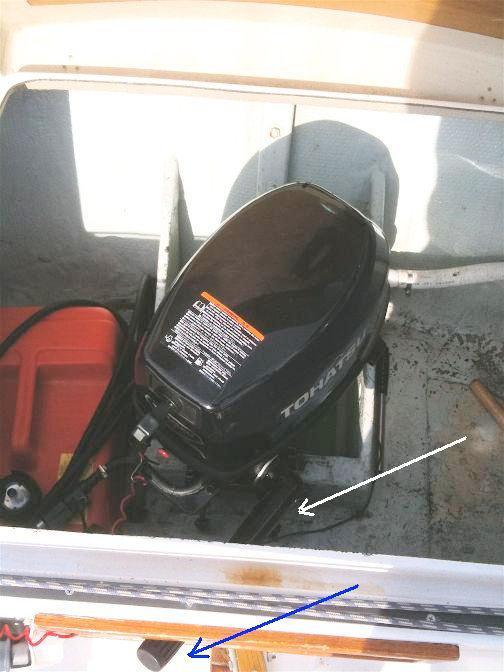
Hi Ron-
As promised, here’s a photo of my Tohatsu 6hp in the motor well. As you can see, it will rotate. I estimate about 35 degrees.
Here’s the catch: the tiller/throttle arm extends through the opening in the forward bulkhead of the motor well (at least on my Yankee... other Dolphins may differ). This gives good access to the throttle when the hatch is closed. But the tiller arm binds on the side of the opening when pushing the tiller to port.
If someone wants to steer with the motor, you could do it with the hatch open, and the tiller tilted up. But I don’t think you will be able to fully close the hatch.
I have found no need to turn the motor, and I always have it locked in the centerline position. I keep the hatch closed when motoring normally, and can access the controls through the opening in the bulkhead.
Hope this helps!
Best-
EKE
September 9, 2012. A good discussion on the Forum regarding throttle handle access slot on a Yankee transom well, and more - here is an excerpt from Erik's Evan's post.
There is an open slot in the cockpit bulkhead at the forward end of the transom locker. When my motor, a Tohatsu 6, is installed in the well, the handle aligns nicely with the slot and projects an inch or so through it. I can run the engine with the hatch closed, and control the throttle through the slot. I can also reach into the slot to access the choke, engine cutoff, and the gear shifter. I do this all the time, no problem. The slot, as well as the two vents in the deck either side of the hatch, seem to provide adequate ventilation.
I do not turn the motor in the well when I use it. I keep it fixed on centerline and use the boat's rudder for all steering. The reason is that with the handle sticking through the slot, the motor will not rotate fully to port - it binds on the side of the slot opening.
This is not a problem since I prefer to use the rudder anyway. It's simpler, and as long as you get used to the turning radii and limitations of manouvering a full-keel boat, it works fine.
Here is the link to the dialogue http://www.dolphin24.org/forum/forum_posts.asp?TID=208
*************************
September 23, 2012. There has been a lot of activity recently, on the Forum, on the subject of outboard motor compartments (sometimes known as transom wells) - see link directly above. A recent post was from George at First Mate Yacht Services in Annapolis, Maryland, who recently completed a restoration of Equinox, Yankee #237. Equinox has a 9.8 hp Tohatsu with a remote shift/throttle assembly. Below is the text of that post - minor edits, and a picture of the motor in the well. (and don't forget we have a whole page dedicated to this subject - click here to go there
My company just finished a full refit on a Dolphin. We installed a Tohatsu 9.8. Got the remote shift/throttle assembly [works like a dream,your engine can likely be retro-fit]. Though the engine can be operated on this boat without acces thru cockpit wall, we cut a large opening anyway to improve ventilation and access to the front of the engine and the mounting bracket.
We made a simple rectangular cover that is held in with a few screws, and added some reinforcement under the mainsheet (traveller) track to compensate for the larger opening. Tohatsu, and I think, most all new outboards, are too big to pivot much in the well, but especially with its remote shift and large prop, this boat manuevers very well and easily does 6.5 kts.
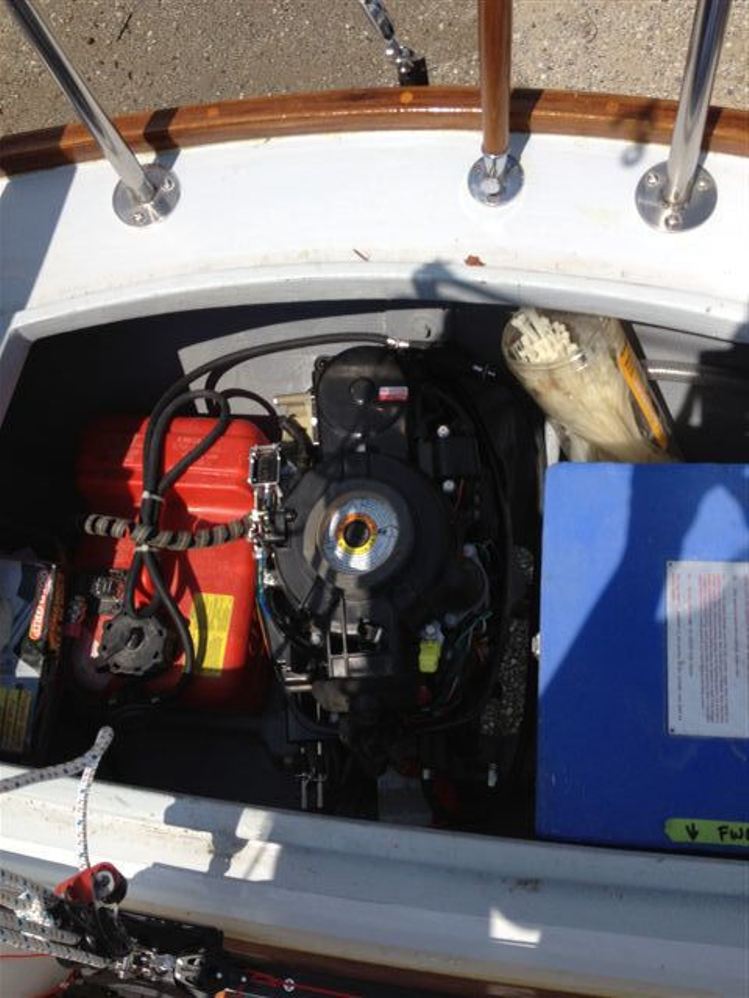
That blue box to the right is a Seaward Liquid Propane Gas Locker kit.
******************************
October 27, 2012. Your webmaster and Mark Steinhilber (Rascal) engaged in a lengthy email discussion regading the pros and cons of ourboards vs inboards. Click here to go there. Click the back arrow on your browser to get back here.
**************************************
January 5, 2013. We haven't had much input on this page from those who hang their outboard off the transom. This option is especially attractive for those whose boats had inboards that have gone to heaven, or hell, depending on one's perspective. Cutting a hole in the hull and the glass work required, especially in a transom locker that was initially sized for an inboard layout can be daunting when the alternative is an adjustable no hassle transom bracket.
Giles Grimston, Falcon 24, Summerwine, has a 9.9 hp outboard and has sent in some pictures and comments on his set up.
Hi Ron
Note the height of the outboard on an adjustable bracket. I lower it to its max in a swell. This is as low as it goes and plenty considering it is a long shaft.
The motor performs best when not too deep, but in a swell I get cavitating so put it deeper to stop that disconcerting scream everytime the prop comes near the surface. Speed is best when not too deep. All this assumes the transom bracket is in fact perpendicular which is a big assumption!
Cheers
Giles
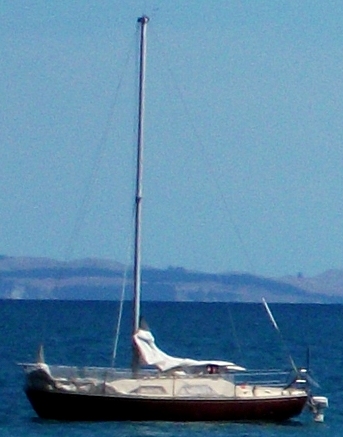 |
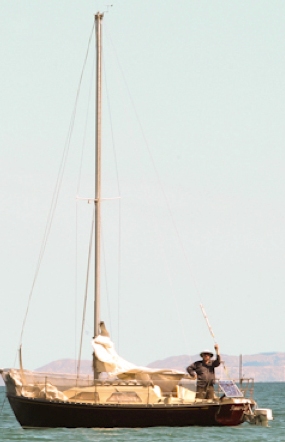 |
motor down |
motor way down |
|
On a follow up question from the webmaster Giles offered the following additional comments regarding the OB position (minor edits)
I have had a wave or 2 over and have to go at an angle through the waves to prevent this. Hard work. I only really use the motor when it is absolutely necessary. They make such a racket and she is so much better under sail in a swell. We get some beuts here after storms but it is awkward when the wind dies on the approaches to the harbor as you get bounce back from the shore as well.
The iron sail is really my last resort and so far has not let me down either. Not bad for a 1976 Johnson 9.9hp.
Giles
************************
|
We had an exchange on the Forum recently that adds to the our collective appreciation of the horsepower issue. This is the link http://www.dolphin24.org/forum/forum_posts.asp?TID=231 The thread is posted below
Topic: outboards
Posted: 02 Jan 2013
Hello All,
Enduring the lousy winter pacific northwest weather I am conjuring trips for the summer. I am wanting to extend my range to the San Juan Islands and into Canadian waters which are 70-80 miles north. However, assuming fluky winds I don't think my 6 hp 2 stroke outboard adequate. I am considering a 9.9 hp 4 stroke if I can find one that will fit into the well. Any advice from anyone would be appreciated.
Jack VanZandt
Olympia, WA
Wanderlust, Yankee #150
Posted: 03 Jan 2013
Jack,
I don't know the condition of your motor, but I think 6hp is plenty. I have a Tohatsu SailPro 6hp 4 stroke and find it to be sufficient especially when cruising. It pushes our boat at hull speed at 1/2-3/4 throttle in calm seas and 3.5 knots fighting a 4 knot current at full throttle. It sips gas. I talked to a guy who used this very motor on his Lapworth 24 from Humboldt Bay to Crescent City (70 nautical miles). He said he motored the whole way and used 5 gallons of fuel.
Hope this helps.
Steve Ludwig
Humboldt Bay, California
El Huachinango, Yankee #80
Posted: 03 Jan 2013
Thanks Steve,
My 2 stroke while very reliable, is noisy and vibrates too much for a long trip. I will be on the lookout for a 4 stroke version. Thanks for the info.
Jack
Posted: 06 Jan 2013,
I use a newer 6hp Suzuki on the (sometimes) swift Columbia River and it pushes her along great. Fits fine in the engine well, but too snug to turn much at all.
Joe Sharpe, Yangui, Yankee #197
*************************************
February 24, 2015. Outboards hung on the transom - a discussion on the Dolphin 24 Sailboats Facebook Group - click here to go there
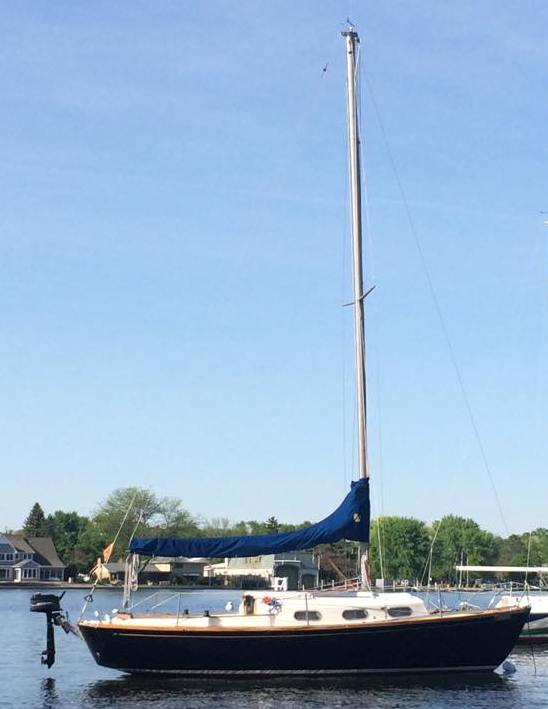
**********************************
February 21, 2016. We had 2 recent email from Dolphin owners with interesting comments about thie outboard motors (in transom well)
From Larry Duthie (Thistle, Yankee #99 - excerpted/edited)
.....your query reminds me it is time to haul the outboard motor to a maintenance shop for a tune-up. The motor I refer to here, is the ancient 9-hp Johnson that Rowland (co-owner) put into her well many years ago. It has a long shaft, and works well. Year before last, however, I pulled that outboard and dropped a much more modern 9-hp Evinrude I bought new a few years back for an inflatable Avon. That motor started far easier than the Johnson, but with a short shaft, it would come out of the water in any kind of chop.
From Scott Henry (Amaya, Yankee #95 - excerpted/edited)
I've been looking off-n-on for an auxiliary without so much drag. The one that came with the boat is a Yamaha 8T (high thrust) long shaft electric start with alternator -- the prop is ~11.5" diameter low-pitch 3-blade. I feel like I'm dragging a motor-sailor prop. Takes 2 people and the vang tackle from the boom end to get it in-n-out of the well. Its pretty powerful though, she does 5 knots at less than 1/2 throttle (in flat water) and hull speed+ at wide open throttle (even against the wind). Even with the extra drag, she still sails well with the newer boats - I almost caught a J-24 to windward in light air once, but I blew too many tacks when the genoa caught on the shrouds.
*******************************
May 11, 2016. Outboard motors in the transom well can get starved for air(oxygen). John (Barbara Joyce, Yankee #141) offered the following on the Forum (minor edits)
I had a two stroke Suzuki 8 hp and had this problem too. Noise was one problem and I couldn't shut the lid while under power.
To quiet the exhaust I taped wax paper over the exhaust outlet holes on the back of the lower unit and laid up a piece of glass about. 1/4" thick. Then I waxed up a piece of PVC about 1 1/2" dia. and wound wet fiberglass tape around it. When it hardened I punched out the PVC and the bored a hole in the flange I had made and bonded the tube to it with a slight downward angle.
I then drilled two holes in the flange and drilled and tapped two holes in the lower end. I used alumalastic (sealing compound) and two stainless #10 Phillips round head screws to hold it on. I gooped the flange with caulk and screwed it onto lower end. That adventure caused the exhaust to come out just under the waterline which meant that as boat moves the exhaust came up behind boat, not IN the well.
Next, I drilled a hole in the side of the engine cover and used a PVC fitting and 3M 5200ed it in place. To this I connected a flexible hose and fit it to the clamshell scoop or duct facing aft that helps ventilate the lazarette. I chose not to hook it to the forward facing vent because of fear of water entering the hose and the engine cover in rough conditions. Now I was able to close the lid and run the engine with very little noise and no fumes in the cockpit while underway.
Webmaster Note: a picture would be worth a thousand words!
**************************
December 19, 2016. The subject of cleaning the fouled outboard came up as Tim Lewis (Pacific Dolphin #264) ponders the problem. We thought your Webmaster's reply needed to be on this page too
Maybe the only option for you is to leave it (the motor) in the well and scrub the lower unit every so often - by swimming or lifting. Check with your local outboard motor shops on what they recommend. Some sailing areas have bigger growth problems than others.
Besides growth on the lower unit I'd be concerned about something getting in/growing in the water intake then fouling the inside of the motor. Happened to me once when I 'accidentally' left the motor down on my dinghy for a week - motor would not run.
Most owners have to deal with lifting the motor out of the water if its going to be left for a while. And some give up and put a bracket on the transom. Uuggh....
This approach is interesting - it was posted on our Forum - I can't vouch for it - and there is still the "growing in the water intake then fouling the inside of the motor" issue.
"Here is a trick I picked up from an old sailor. Cover the bottom half of your outboard with automobile wax. Put it on heavy and don't rub it off. Not much will stick to the engine and you can probably go 2 months before cleaning. The fellow who told me about this was hosing off his rubber dingy when I met him. After two months in salt water most every thing on the bottom just hosed off. Don't cover the sacrificial zinc with wax."
Here's a link worth reading http://www.marineenginedigest.com/diy/bottom-paint-for-outboards.htm
At the end of the day I think you have to lift your motor every so often to clean it, how often depends on your local growth situation, and the effectiveness of any coating. That's why I like my 'light' 4 hp motors, plus the boat sails faster without having the drag of the motor.
Click here to go to the Forum thread on this subject
********************************
December 20, 2016 Paul Lugin, (Windswept too, Yankee #245)
read the above comments and submits the following
Hi Ron,
I would like to add to the comments about outboard motors. Presently I am using a 4 hp Tohatsu four stroke which weighs about 58 pounds .This past season I kept the motor in the well and did not pull it until I got the boat home at the end of the season. There was more growth than I can tolerate and I worry about corrosion so I plan too pull the motor at the end of each visit ( about 1 week ).
Pulling the motor wasn't all that hard for me but the process is awkward as you have to spin the motor to get it out. I worry about injury and being 67 years old I expect I'll be less strong as time moves on. I've been thinking about a small lightweight crane similar to my mast crane.Click here to go there.
I think that would work and could probably connect to the genoa winch also, but this would have to be stored on board and would take up some space and add a little weight.
I was looking at this picture of Windswept and from the photo it looks like I could raise the boom a bit with the topping lift, disconnect the mainsheet blocks from the traveler, connect the mainsheet lower block to a strap ( or straps ) on the engine, and then use the mainsheet blocks to lift the engine out of the well. You could then lower the engine to the cockpit sole and go from there.
I think it would be wise to tie off the boom so it doesn't swing away once the motor clears the well. Do you know if this has been tried?? (Not that I know of) If not, maybe someone lucky enough (or is it smart enough ?) to still have a boat in the water can try this out.
Thanks Ron for all you do
Paul |
|
Webmaster replies: I think your idea of using the mainsheet system to raise and lower the outboard has merit. Lets see if anyone responds.
Pulling the motor from the well and easing it into the cockpit may be easier than pulling it from the cockpit and positioning it to lower into the well.
My thought - a removable (ss) steel rod maybe 1/2 dia, 3' to 4'? long, gets suspended below the boom - from eye at the end of the boom to a forward strap around the boom. Maybe, if necessary, some kind of roller 'block/car' with an eye slides on it, to which is fastened the main sheet system. After the motor is pulled up from either location it is slid to the new location and lowered. Maybe a pre-positioned set of cushions and a tie down strap (with lock?) in the cockpit.
A second thought - the main strap on the motor probably gets secured to the head so that the motor hangs prop down. But when its pulled it would neat to have a second strap (system) linking the head to the lower unit so that the unit goes horizontal instead of vertical when pulled from the well, and vice versa when pulled from the cockpit.
******************************
April 5, 2017. After reading Paul's comments above Scott Henry (Amaya, Yankee #95) sent in the following comments (minor edits) about pulling his heavy outboard motor from the well using his boom. Alas, we have no pictures....This matter has come up before and is scattered around the Technical and Roster sections. Time permitting, staff will try and consolidate 'boom lift' comments into a single page. This a start......
Hi Ron,
I just the above article about #245 , a question about using the boom to raise the outboard. When I bought Amaya, that is what the previous owner said he used to raise the outboard. Since my OB is >100lbs weight, I attach the vang tackle to the end of the boom, raise the boom with the topping lift. The mainsheet limits the movement of the boom athwartships.
A greater than 4-part tackle would be an improvement, as would a longer boom (though it would then hit the backstay more...). One time I picked up a trash bag with the prop (it may have been two) when motoring in a nearby channel. With a deck brush I managed to get enough of it off that I could limp back to the slip, where I lifted the engine to finish cleaning it off. I've been mentally designing a boom extension for the purpose of removing and replacing that big OB a little more easily.
About 1x/year I take it out and put anti-fouling paint on it. I just put it back in a couple of weeks ago, though I didn't think to take pictures (I can *just* handle the job single-handed with the boom crane.). The old prop was so beat up that I determined that the price of a new one was worth it (the last 2 times I spent more time trying to fair the prop than all of the other work).
Down-side of the new prop: my minimum speed is higher! In the SF bay we can sail year-round, though sometimes the currents are stronger than the wind.
Scott
Postscript: A
webmaster followup question re Scott's topping lift set up
Question - my topping lift is adjustable by a relatively light weight block and tackle system http://www.dolphin24.org/technical_booms.html. Is your's similar?
Scott's reply
I left it the topping lift the way the prior owner set it up: a 5/16" line runs from the end of the boom to a block at the masthead, then down to a cleat. I use the jib halyard winch when dealing with the outboard.
*********************************
July 10, 2017 Rick Kennedy (Boethius, Yankee #149) sent in the the following re lifting his outboard
I have been moved by the Powers that Be to a new mooring in America's Cup Harbor in Shelter Island where I sit now parking-lot style with a Catalina bow-stern mooring. This means I now need to use my motor every time I want to sail.
Given pending back issues in my old age, I had to figure out a way to raise and lower the motor with minimal strain.
Here are pictures:
Click on these photos for larger images
Webmaster Note: We have added these pictures and Rick's relevent comments to the Technical Section on outboard motors - click here to go there |
|
|
|
***************************************
September 22, 2017 - Carl Harrington (Yankee Girl Esther, Yankee #89) replied to a "reverse info' request made on the Dolphin 24 Facebook page by Astrid van Buren (http://www.dolphin24.org/Ocean_Gypsy.html, Yankee #80). Website staff met early this morning and agree wholeheartedly.
The Dolphins steer poorly in reverse with outboards in the well behind the rudder compared to inboards with a prop aperture in front of the rudder. Harder for this with larger outboards that can't rotate in the well (like my 9.9) but who would desecrate the beautiful stern with an engine bracket? Also, the full keel prevents quicker turning like a "modern" fin keel boat. They were designed to go straight on bigger water (Midget Ocean Racer) rather than turn frequently around the buoy short course.
As Douglas Adams said about a spaceship "Looks like a fish, flies like a fish, steers like a cow" in reverse in this instance. Take it slow, easy in the throttle, keep your fenders out and Boat hook ready till you're in open water.
Thanks Carl!
**********************************************
June 2, 2019 - check out Matt Kapp's comments on his new outboard - a Yamaha F6 - Sanguine, Yankee #219
**************************
|
